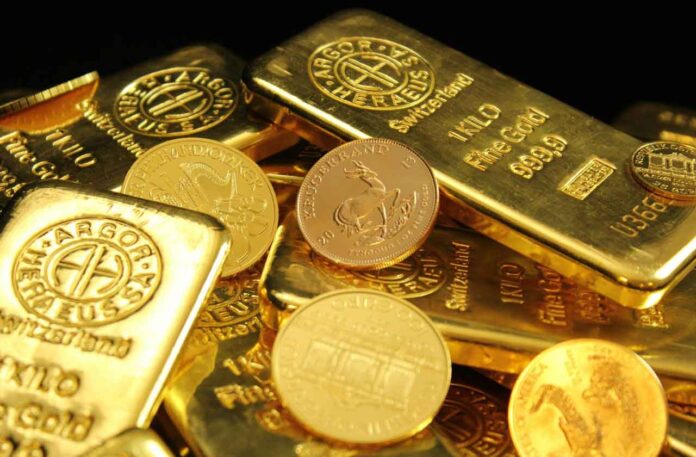Physical gold assets, such as gold coins or bars, can potentially be a beneficial portfolio inclusion, according to Kevin DeMeritt, founder and chairman of the Los Angeles-based precious metals firm Lear Capital.
Precious metals’ generally consistent value — due in part to factors such as their range of applications and limited overall availability — has helped maintain the demand for assets; gold prices, for instance, have primarily been constant or increased during the past 200 years, National Mining Association records show.
At times, gold’s price has risen considerably, such as in the period between 2008 and 2012, when the producer price index for gold leaped 101%. Since 2001, the precious metal’s price has actually increased by 566%, according to a Lear Capital analysis.
Gold recently hit a number of new price point highs in the first few months of this year — including $2,222 per ounce on March 21 and $2,300 on April 4.
Gold’s March and April price escalation culminated with a surge above $2,400 an ounce on April 12. Thus far in 2024, gold’s price has risen approximately 14%, according to CBS News — which also noted gold investing reached an 11-year high last September.
While those recent elevated price points may make selling some of your physical gold holdings tempting, you may want to consider a few other elements, aside from the ability to turn a quick profit.
The Enduring Demand for Gold
Gold, according to Kevin DeMeritt, is frequently perceived to be a fairly liquid asset, compared to a number of other investment vehicles.
Fees can be involved, for instance, if you withdraw your money from a certificate of deposit before the end of the agreed-upon timeframe. Assets with a tendency to be more reactive to world and economic events, such as stocks, that may perform less consistently than gold could make finding a buyer somewhat complicated in instances where they’ve lost a significant amount of value because of recent conditions.
Gold’s liquidity may be why central banks have enthusiastically been purchasing the precious metal; its performance during crisis periods and status as a long-term store of value are two key reasons the banks value the asset, according to a 2022 World Gold Council survey.
That year, central banks bought a record-breaking 1,136 tons, according to the World Gold Council — 152% more than in the year before.
In 2023, central banks “maintained a breakneck pace” in regard to their gold buying practices, according to a World Gold Council report and their annual net purchases almost reached 2022’s record level.
“The central banks have been piling into gold because we’ve printed up so much money, now there’s a distrust that [the United States will be] able to service the debt,” Kevin DeMeritt says. “The central banks [are] holding gold because they understand the paper and the digital currencies could potentially go away. They need something that’s physical and has value.”
In March of this year, Turkey purchased 14 tons of gold, and China and India each added 5 tons to their holdings. Overall, in the first quarter of 2024, Turkey obtained more than 30 tons of gold, China bought 27, and India added more than 18 tons.
Global financial institution ING said in an April gold market update that the appeal the precious metal holds for investors as a safe haven asset “is likely to continue for the rest of this year.”
In addition to buying gold, as central banks’ recent activity has shown, they’re also able to sell it when they want to. The Central Bank of Russia, for example, has periodically reduced its holdings in the past three years by about 3 tons, and then replenished that amount.
In the first quarter of 2024, Russia’s central bank sold 3 tons of the metal. In March, World Gold Council records indicate collectively, central banks sold 25 tons of the precious metal.
Why Selling Gold Isn’t Your Only Option When Prices Rise
Assets like gold that offer considerable liquidity, at least in theory, shouldn’t present as much pressure to sell the items, if an opportunity arises, as assets that involve more constraints.
Holding on to gold can potentially position you to take advantage of any future price increases. If the precious metals’ performance history is any indication, its value could possibly continue to rise higher.
Several aspects might push gold prices upward this year — including the Federal Reserve’s anticipated rate cuts, which could equate to higher prices, since in the past, the precious metal’s value has risen when interest rates increased, Kevin DeMeritt says.
As interest rates ascended to a new high of more than 15% in 1980, for example, gold’s price more than doubled, zooming past the previous record amount, according to Lear Capital data.
“When investors are worried about the economy or global events, usually you get more people turning to gold, which can drive up its price,” Kevin DeMeritt says. “We’re starting to see that more and more.”
The Lear Capital founder says including a variety of investments in your portfolio, particularly if they involve different time-related goals and performance tendencies, can potentially help reduce risk by buffering the impact if other assets experience losses.
Some investors approach gold and other physical precious metals as long-term assets, and add stocks to their portfolio as more of a short-term option, due to their ability to rise and provide returns — or just as quickly decline in value.
“You need to look for that asset that’s going to give you the stability and offset the volatility from some of the other areas,” Kevin DeMeritt says. “Gold can be a great diversification tool — [and] diversification usually works out much, much better for people over the long term.”







